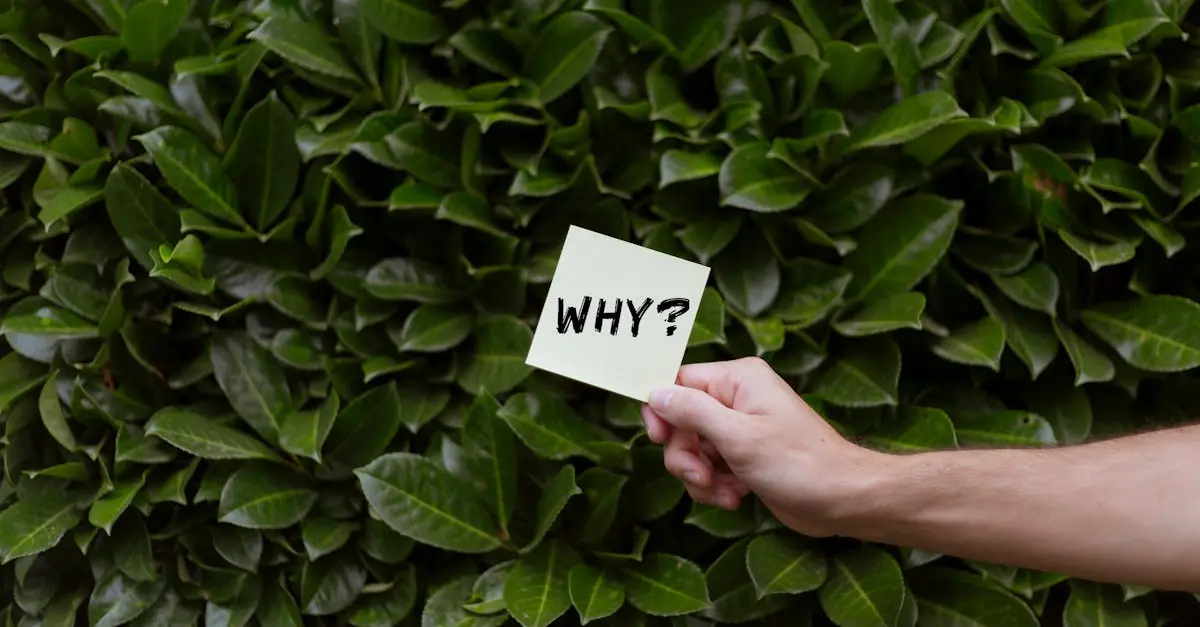Ever sent a text on your iPhone only to watch it morph from the soothing blue of iMessage to the alarming green of SMS? It’s like watching your favorite superhero turn into a villain right before your eyes. This mysterious transformation can leave anyone scratching their head, wondering if their message got lost in the digital Bermuda Triangle.
Table of Contents
ToggleUnderstanding Message Colors on iPhone
Message colors play a significant role in communication on iPhones. Users notice a shift from blue to green, which can lead to confusion.
Blue vs. Green Messages
Messages appear in blue when utilizing iMessage. This service provides features such as read receipts and typing indicators. Green messages signal that the text sent as a regular SMS or MMS. Certain conditions, like the recipient not having iMessage or being offline, trigger this change. Users can find it helpful to understand these differences for a smoother messaging experience. The transition from one color to another might seem alarming, but it mainly indicates the type of service being used.
What Each Color Indicates
Blue messages indicate an active iMessage connection, showcasing Apple’s messaging features. In contrast, green messages represent standard messaging through the carrier’s SMS network. iMessage operates over Wi-Fi or cellular data, while SMS relies on a cellular signal. Receiving a green message may lead users to speculate about the recipient’s connectivity. Understanding these differences enhances clarity about message delivery status and potential connectivity issues. Recognizing the implications of each color makes communication more efficient and less confusing.
Reasons Messages Turn Green
Messages often change from blue to green for various reasons. Understanding these triggers helps clarify why communication may not proceed as expected.
SMS vs. iMessage
SMS messages appear in green, while iMessages show up in blue. iMessage functions exclusively between Apple devices, providing enhanced features like read receipts and media sharing. If the recipient doesn’t have iMessage enabled, texts revert to SMS, represented by green. This situation often arises if friends using non-Apple devices receive messages. Ultimately, the display color indicates the type of service being utilized, and recognizing this distinction can prevent confusion.
Connectivity Issues
Connectivity issues frequently lead to changes in message color. Poor internet connection or being offline disrupts iMessage functionality, forcing the iPhone to default to SMS. When Wi-Fi or cellular networks become unreliable, messages can turn green, regardless of the recipient’s device. Users may also encounter problems if iMessage settings aren’t correctly configured. Ensuring a stable connection can help maintain the blue message status, resulting in a smoother texting experience.
How to Fix Green Message Issues
Green messages on iPhone can stem from various issues. Resolving these concerns often enhances the messaging experience.
Checking Network Connection
A stable, reliable network connection is crucial for iMessage functionality. Users should first verify if their iPhone is connected to Wi-Fi or cellular data. Disconnecting and reconnecting the network can help refresh the connection. Poor signal strength may hinder iMessage delivery, causing messages to revert to green. Testing the connection by loading a website can confirm if the internet is active. Additionally, users can toggle Airplane mode on and off, which resets network settings temporarily. Ensuring a strong connection can significantly enhance the chances of maintaining blue messages.
Updating iOS
Updating the iOS version can resolve many messaging issues. Apple frequently releases updates that fix bugs and improve functionalities. Users can check for available updates by navigating to Settings, then selecting General and Software Update. Installing the latest version enhances the overall performance of the device as well as messaging capabilities. Outdated software may interfere with the iMessage feature, leading to unexpected green messages. Keeping the iPhone’s operating system current is a straightforward way to ensure seamless communication with others. Regular updates often bring security enhancements as well.
When to Worry About Green Messages
Green messages typically indicate potential issues that may require attention. Users might notice green messages when communicating with non-Apple devices. If the recipient’s phone isn’t connected to iMessage, messages will default to SMS.
Connectivity problems can also lead to this change in message color. Poor internet connections often disrupt iMessage services. Without a stable network, users may not send or receive blue messages.
Checking settings is critical when trying to avoid green messages. Users should verify that iMessage is enabled in their settings. Accessing “Settings,” then “Messages,” will confirm if iMessage is turned on.
An iOS update may resolve issues associated with green messages. Apple regularly releases updates that include improvements to messaging performance. Ensuring the device runs the latest version of iOS helps maintain reliable communication.
Reaching out to the recipient can clarify if they have issues with their iMessage. Confirming their device status may reveal whether the problem lies with their iMessage settings. Some individuals may intentionally choose not to use iMessage, leading to the default SMS option.
Monitoring overall device performance is essential too. If the iPhone experiences frequent issues, it may signal an underlying problem, such as software bugs. For persistent issues, contacting Apple Support can provide professional assistance and troubleshooting advice.
Green messages shouldn’t always be a cause for alarm, but consistent occurrences warrant further investigation. Observing connectivity status, settings, and device updates can help users maintain a consistent messaging experience.
Conclusion
Understanding why messages turn green on iPhone can alleviate confusion and enhance the overall messaging experience. This shift from blue to green often reflects the type of service in use rather than a failure in communication. By recognizing the implications of each color users can navigate their messaging landscape with more confidence.
Staying informed about connectivity issues and ensuring iMessage settings are correctly configured can help maintain seamless communication. Regular updates to iOS also play a crucial role in optimizing messaging capabilities. When green messages appear frequently it’s wise to investigate potential issues to ensure reliable and efficient texting.






